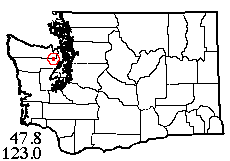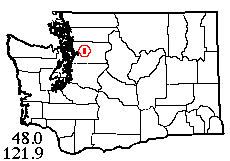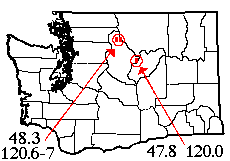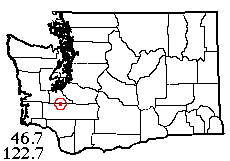
Spider Collector's Journal (9th page: 1998) Copyright © 2005 by Rod Crawford
As explained on the first page, most of these notes of fun (and not so fun) trips to collect spiders for research at the Burke Museum appeared in Scarabogram, newsletter of "Scarabs: The Bug Society," in their original forms. References to the editor mean me; most other persons mentioned are Scarabs members. Dates of field trips head each paragraph. Maps showing the location of sites within Washington state follow the grid system outlined in the Washington Spider Checklist. RETURN TO INDEX
 |
20 VI 1998: I was wanting to test my newly healed hand after the Russian accident, and Jerry Austin had expressed an interest in a field trip, so I selected a promising spot in the foothills along the south fringe of the Olympic Mountains, an area not well sampled for spiders. The roads in that part of Olympic National Forest are truly mazelike, and at one point I had to bring out my new GPS to find out where we were. Finally, after Jerry's poor old (now defunct, but not for that reason) car scraped bottom a few times, we arrived at the Church Creek trailhead, ready to hike the short distance to one of the Satsop Lakes. At only a moderate elevation, these little lakes are very secluded, and we didn't see a soul. There were meadows of grass, bracken and Rubus pedatus, a willow thicket, and some semi-old growth hemlock (perhaps 100 years old following a fire). Due to the dryness of the winter, the season was advanced and collecting not that good: 21 spider species, none very unusual. But it was nice to get out.
 |
18 VII 1998: My still less than perfectly limber left hand (not to mention my whole body) needed more exercise, and butterfly folks Jon (former Scarab) and Zack Pelham and Scarab Hiruma offered to take me along to the classic Mt. Townsend locality, a good trail from 3260' to the 6280' summit. Despite the higher elevation, the late season was even more evident, things were very dry and spiders sparse. A few were taken on fir foliage at Windy Camp but everything good was from the summit ridge. I got a new Lepthyphantes (my 16th) under a rock; Zack, Kiyoshi and I got one each of the rare wolf spider Pardosa concinna; and Jon got a rare jumping spider that has only been found in Olympic alpine habitats. I also found out that my injured hand needed more practice picking up rocks (it's improved since then), and that a GPS unit that "thinks" it's at sea level will be about a mile off at 6000 feet!
 |
26 VII 1998: Quite a few Scarabs showed up for the official field meeting at Dave Pehling's place near Granite Falls, but yr editor can find no list of who all attended. As Scarab Mascall reported in the newsletter, Dave and Lori live in the foothills amid second growth at the end of a rural road. The early arrivals toured Dave's array of experimental bee housing around the farm buildings and the contents of pitfalls Dave had set up along his woods trail past the pump house, observing various wildlife including Dave's population of slug-eating garter snakes. I arrived later with Scarab Collman and collected 29 spider species from fern understory of mixed forest, sifting alder-conifer litter and moss, beating conifers (mainly in the adjacent tree farm stand on state land), and poking around the farm buildings. Most interesting was a male of the uncommon (in Washington) orbweaver Neoscona arabesca. Collecting was better than I'd expected considering my less-than-great previous two trips. After dusk, Sharon got in some great weevil collecting, mostly at the edge of the tree farm.
 |
| Above: Locations of Chelan Butte and Stehekin Valley Below: Stehekin Valley showing spider collecting sites |
 |
21-25 IX 1998: The Week in Stehekin. Courtesy of the National
Park Service, yr editor and Jerry Austin spent the week of Sept. 21-26 in and
around the remote village of Stehekin, Washington. While there, Jerry climbed
a peak in Stehekin. We collected up a creek in Stehekin. We found what we were
seekin': something unique in Stehekin...
The Stehekin Valley
forms the northern inlet of Lake Chelan, a 53-mile long, extremely deep freshwater
lake accessible by road only at the south end (city of Chelan). Stehekin village
was founded over 100 years ago but still has no telephones, very few private
cars, and only 75 year-round residents. When North Cascades National Park was
formed, the non-private land around Stehekin was made part of the buffer-zone
National Recreation Area; thus the NPS presence. In fall of 1997, study of a
core soil sample from an NPS archaeology site close to the Stehekin River yielded
a presumed "spider" specimen at a level they assumed to be 900 years
old. The specimen came to me for examination (in an understandably sorry state).
It was a harvestman, not a spider, and amazingly belonged to the genus Paroligolophus
with two known species (both European), one of which was introduced to the Puget
Sound area somewhere around the late 1960s. The easiest explanation is that
the sample somehow got contaminated. But where? To answer this, it was necessary
to take the first-ever sample of the Stehekin Valley's arachnid fauna. Thus,
our trip.
The boat for Stehekin
leaves Chelan first thing in the morning, so we had to drive over the previous
day. Rather than waste a day, we did some spider collecting in the Chelan area.
A road up to Chelan Butte Lookout through extremely parched state land brought
us to a series of Populus-conifer riparian woodland strips. In one of
these, the leaf litter proved bone dry and nearly spiderless, whereas spiders
were on the vegetation in almost normal numbers. A few worthy specimens were
found under dead tree bark also. In search of more moisture we went down to
Lakeside Park on the shore of Lake Chelan itself, which yielded a considerable
number of mostly synanthropic species.
Arrived in Stehekin,
we found that even bureaucracy is relaxed in such a place. A guide to the best
local habitats? No problem. Find us places in the woods where we can plug in
our moth collecting light? No problem. Lend us a vehicle? No problem. Send someone
around in 3 weeks to pick up our pitfall traps? No problem...we hoped. Our first
stop was the infamous archaeological site (1 on map), where the habitat
of the harvestman in question (leaf litter) was bone dry and essentially free
of any specimens. A fair collection from vegetation (grass meadow, fir forest)
and river rocks was taken; no harvestmen at all. Ten pitfall traps were set,
using propylene glycol as a preservative, reportedly superior to (and less toxic
than) the old style antifreeze traps.
First night's moth
collecting was done at a remote cabin subject to river flooding but still amazingly
supplied with a working electrical outlet. Very nice late-summer moths including
Catocala relicta. Our friendly ranger guide actually found us a wetland
for our next sample area (2 on map), which just happened to be at one
end of the Stehekin airstrip. We're not talking Sea-Tac here; the strip is surrounded
by forest and, on the day I was there, was visited by about 4-5 single engine
planes. I spent hours in the hot sun setting another 10 traps here, hoping the
staff could find them! Most of my hand collecting was done in the adjacent swampy
alder forest, which actually had a few leaf litter spiders, as well as plenty
in other habitats.
Our second night's
moth collecting was done not far from this airstrip at an NPS garage-fuel facility
which is ordinarily floodlit; they agreed to turn the lights off for one night
for our purposes. So we collected normally for 12 or 13 minutes...then were
amazed by the arrival of at least 6 big brown bats, which spent the rest of
the evening nabbing "our" moths before we could get them. Occasionally
they even flew right in front of us. I'm not kidding! With these poachers in
action, exactly 2 moths and 1 caddisfly arrived at the light until we finally
gave up. We assume they got this habit by foraging around the NPS floodlight.
The Buckner Homestead
(3 on map) is a historic farm site pioneered in the 1890s, with the buildings
and implements kept as they were just prior to WWII, complete with house spiders.
Learn while you collect! Another day, we hiked up to the protected gorge of
Boulder Creek (4 on map), setting more pitfalls and collecting in ravine
bottom habitat. Not too productive but certainly better than the parched upland
forest (5 on map), which yielded scarcely a specimen! Perhaps the spider
highlight of the trip was a visit to scenic Rainbow Falls (6 on map),
where we finally found a truly mesic habitat, a perilously steep meadow (7
on map) in the fringes of the falls' spray zone. For the last day, I concentrated
on collecting household species around the ranger station (8 on map)
and boat landing buildings (9 on map). As for the nominal purpose of
our visit, the entire stay in Stehekin produced only 1 or 2 harvestman specimens,
not including the core sample genus, Paroligolophus. In fact,
I didn't even find it in Chelan! So perhaps the sample was contaminated in western
Washington? We would see what the pitfall traps yielded, assuming the rangers
could find the darn things...
[Now the results,
finally compiled in 2004. The rangers did indeed find the pitfalls in all three
areas (sites 1, 2, 4 on map above) and the catch was excellent. The propylene
glycol was a success: the catch was well preserved and included no unwanted
vertebrates. Our trip brought the known spider fauna of the Stehekin area from
0 to 56 species, plus 4 species of harvestmen, 2 of pseudoscorpions, and 3 of
centipedes. One harvestman, Leptobunus californicus (site 4), was a state
record for Washington. Males of Cicurina sp. #2 were taken for the first
time (site 4), which will enable someone to describe the species. The most unusual
spider was a jumping spider male (site 1) whose 2 palps look like they belong
to different species. One sad finding, the invasive European orbweaver Metellina
segmentata (site 2), which is displacing native relatives, is already in
this remote area.]
 |
9 XI 1998: The morning of Monday, November 9 saw yr editor and Jerry
Austin, spurred by a favorable weather report, heading south on I-5 to collect
on Napavine Prairie in southern Lewis County. Everything looked fine as we passed
through Tacoma, Olympia, Centralia...but pulling into Napavine, we pulled into
an unexpected rainstorm, which (after a half hour's wait) showed no signs of
abating!
Fortunately, we
had backup collecting plans! So retreating back north out of the rain, we exited
in Centralia and headed northeast to the Hanaford Valley. Some 6 miles long
and half a mile wide, this flat bottomed valley was formerly agricultural but
is now the site of the Centralia city power plant, a huge square building generating
steam power from coal, which comes from huge new strip mines in the surrounding
hills. Fortunately the mines do not impinge on the valley itself, which has
some prairie characteristics. We found a gated logging road we could hike up
to a forest-meadow mosaic along a stream in the upper valley, and went to work!
First on the agenda
was sifting leaf litter from maple and Oregon Ash, the latter being very common
at the site. Jerry checked out logs and found some thick deposits of spider
bearing moss. The day warmed up enough for grassland spiders to start ballooning,
so I took a sweeping break in a sedge meadow. Moss sifting followed; then, as
the rain finally caught up with us around 3 PM, I took 20 minutes to beat coniferous
tree branches before retreating to the car. In approximately 4 hours collecting
at 2 adjacent sites, we got no less than 50 species of spiders! (Including 20
from the moss sample alone). At least 3 species were not immediately recognizable.
This should give readers an idea of why I'm so fond of collecting in the fall.
This page last updated 21 March, 2025